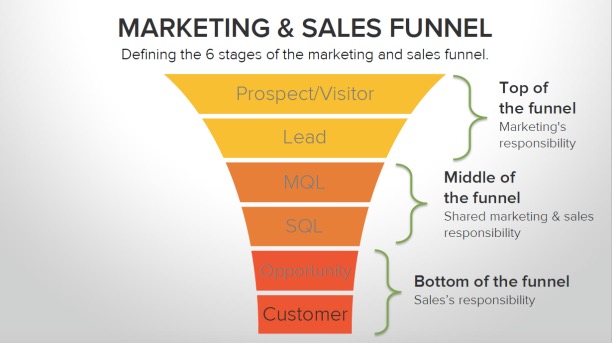
Sales and marketing are part of the same team, but how well they work together has a huge impact on the success of your company. Aberdeen group reports that companies with strong sales and marketing alignment experienced 20% annual growth, while companies with poor alignment experienced 4% revenue decline. If you’ve worked in either environment, you know how rewarding it can be to have strong alignment. It makes for happy teams, but even better – it yields results. For the greatest impact, integrate sales and marketing by focusing on 5 essential steps.
1. Align Sales And Marketing Goals
To build a proper foundation, align sales and marketing around a common set of goals to increase revenue. Of course each team will work toward the goal in slightly different ways, but these efforts should be closely linked. For example, marketing’s top priority shouldn’t be a traditional media advertising campaign if what sales really needs is prospecting or conversion help. If marketing is focused on increasing qualified leads, sales should have skin in the game to follow up on those sales-ready leads.
2. Agree On Sales Funnel Definitions
According to a CSO Insights study underwritten by Velocify, less than 50% of companies have an agreed-upon definition of a qualified lead. I’ve seen situations where teams within the same company used different names for the same stage of the sales funnel. Ouch. You know you’re not aligned when that happens. To ensure both teams are speaking the same language, clearly define each stage of your funnel. HubSpot recommends these categories:
Visitor/Prospect – Someone who attended your event, visited your website or signed up for your newsletter.
Lead – A contact who has submitted a form in exchange for value (eBook or whitepaper)
MQL (Marketing Qualified Lead) – Contacts who have “raised their hand” and identified as more deeply engaged.
SQL (Sales Qualified Lead) – MQL’s that your sales team determines are worthy of direct follow-up
Opportunity – SQL that a sales rep has communicated with and marked as a true potential customer
Customer – this should be self-explanatory
Marketing owns # of Visitors and Leads (top of the funnel). Sales owns # of Opportunities and Customers (bottom of the funnel). MQL and SQL (middle of the funnel) should be jointly managed to ensure a smooth handoff. I normally dislike joint ownership. In this case it not only makes sense, it’s essential.
3. Create A Service Level Agreement Between Sales And Marketing
It’s shocking how rarely sales and marketing teams formalize their expectations with each other. A Service Level Agreement (SLA) defines each team’s commitment to one another in support of the shared revenue goal. Creating an SLA helps clarify what it will take to hit the revenue target. It also clarifies who owns each stage of the sales funnel. Lastly, an SLA forms the basis for dashboards and ongoing communication. Be sure to include:
- Overall revenue target
- Average revenue per customer
- Lead conversion % and # of new customers needed
- # of leads needed and quality of leads
- # of call or email attempts per lead and depth of follow-up
In the SLA, Marketing commits to # of leads and quality of those leads. Sales commits to speed and depth of follow-up.
4. Create Visible Dashboards And Closed-Loop Reporting
I’ve seen daily and weekly dashboards that are pages long. Gnat’s a** level details are not what we’re talking about here. There’s a reason we call it a dashboard and not an owner’s manual! Here are a few things to keep in mind:
- Identify 5 metrics that clearly explain whether you are on-track to hit the revenue goal and deliver on SLA commitments
- Make metrics and results visible with an easy-to-read, public dashboard
- When things go well, celebrate
- If results fall short, use data to engage in a positive discussion about how to get back on-track
The dashboard is high level and provides quick insights on results vs targets, but you also need closed-loop reporting to improve processes and avoid frustration.
I’ve been in a lead generation leadership role. It’s frustrating to generate thousands of leads, but have no idea whether sales followed up. Did the leads end up being any good? Which marketing activities generated the best quality leads?
I’ve also been in a sales leadership role, where we had duplicate leads, no lead scoring and low quality leads. How had these leads (potential customers) engaged with our company? How should we prioritize leads? Which leads are sales-ready? How can we use marketing insights to improve close rates?
Without dashboards and closed-loop reporting, you’ll be missing the answers to these important questions. Without daily, public, transparent reporting, it’s easy to lose sight of success.
5. Over-Communicate
On average, sales and marketing teams only meet 4.7 times each year to formally discuss the above items (Aberdeen). That’s barely more than once each quarter! Communication by itself isn’t enough, but it’s essential to enable alignment. Once a quarter is simply not enough.
I recommend weekly joint staff meetings, where sales and marketing teams can get on the same page. To ensure teams get the most out of this time together:
- Don’t let these meetings ramble.
- Focus on what’s working, SLA results and process improvements.
- Allow marketing to bring sales up to speed on new products or marketing collateral.
- Allow sales to share pain points for marketing collaboration.
Once you’ve integrated sales and marketing, be sure to reinforce that alignment by over-communicating. Discuss overall goals, sales funnel, SLA, dashboards and closed-loop reporting. Talk about what’s working and not. Support the other team when they are struggling in a specific area. Collaborate and stay on the same page. Do all of this regularly and frequently.
Integrate Sales And Marketing For Results
If you want revenue growth, you can’t afford to ignore the dynamics between sales and marketing any longer. Begin with alignment around shared goals, then take steps to reinforce that alignment. Integrate sales and marketing for results, not just for happy teams.

